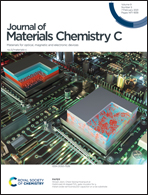High-contrast mechanochromic fluorescence from a highly solid-state emissive 2-(dimesitylboryl)phenyl-substituted [2.2]paracyclophane†
Abstract
It is still very challenging to obtain mechanochromic luminescence (MCL) systems that combine high-contrast photoluminescence colour change together with high quantum yields in any morphological state. In this paper, we have disclosed the reversible and high-contrast MCL properties from a triarylborane-based [2.2]paracyclophane, g-BPhNMe2-Cp, which contains 2-(dimesityboryl)phenyl and dimethylamino groups at pseudo-gem positions. With mechanical grinding, this compound exhibits a remarkable fluorescence change from blue fluorescence of the crystalline pristine powder to the green fluorescence of the amorphous ground powder with high fluorescence quantum yields of 0.58 and 0.73, respectively. In addition, the blue fluorescence can be reversibly restored upon fuming the ground powder with solvents. The structural analyses revealed that this compound is featured by a rigid and congested structure, which is helpful to suppress the intermolecular interactions, such as π–π stacking, aggregation, and excimer formation, and consequently enables the intense fluorescence in both morphological phases. The theoretical calculations suggested the remarkable two-colour fluorescence switching of g-BPhNMe2-Cp arising from the alternating excited state conformations formed in the crystalline and amorphous phases due to the different degrees of structural relaxation in the excited state.
![Graphical abstract: High-contrast mechanochromic fluorescence from a highly solid-state emissive 2-(dimesitylboryl)phenyl-substituted [2.2]paracyclophane](/en/Image/Get?imageInfo.ImageType=GA&imageInfo.ImageIdentifier.ManuscriptID=D0TC05307D&imageInfo.ImageIdentifier.Year=2021)


 Please wait while we load your content...
Please wait while we load your content...